It’s hard to find someone who has never heard of the guppy fish (Poecilia reticulata). It is one of the most common and popular aquarium fish around the world. For the vast majority of lovers, the guppy became the first fish to be kept, and the experience of caring for it became a pass to the big world of the aquarium hobby.
General information
A characteristic feature of the guppy is egg production. Unlike most other fish, eggs are fertilized and developed not in the external environment, but in the body of the female. As a result, an already formed fry is born. This increases the fry’s chances of survival.
The first fish to be in space were also guppies. They not only successfully adapted to life in zero gravity aboard the Salyut-5 orbital station but also managed to produce offspring. Genetic scientists use them to study the transmission of hereditary traits.
Also, guppy fish have rendered a huge service to the world community. The fact is that these fish happily eat the larvae of anopheles mosquitoes, and to combat these parasites, guppies were settled in the water bodies of many countries.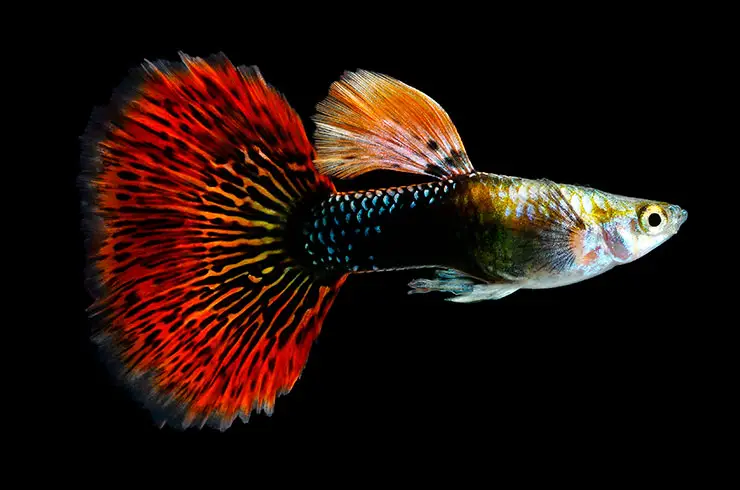
Appearance
Guppy is a small fish from the Peciliaceae family. The average body size in the male is 3 cm, in the female – 6 cm. The scales are in the form of a rhombic mesh, for which the fish received the specific epithet from the Latin “reticulum” – mesh. Fish are characterized by pronounced gender dimorphism. Females are much larger and thicker than males, do not have strongly developed veil fins, and are much more modestly colored: mostly the body and tail are gray, sometimes the caudal fin is colored or spotted. The most important distinguishing feature of males is the presence of a modified anal fin, which is called gonopodia. Thanks to him, males are able to place gender products directly into the abdominal cavity of the female, where fertilization already takes place.
As for the color, natural individuals cannot boast of a bright outfit: a gray body and small (albeit absolutely unique in location) spots on a rounded tail fin. This allows you to effectively hide from enemies among dense thickets. A completely different matter is breeding forms, which have been bred by amateurs and professionals around the world for a long time. Several stable groups of fish are distinguished, depending on the shape of the caudal fin and body color. Guppies can be monochromatic, spotted, with a metallic sheen, etc. It is impossible to list all the colors and shapes of guppies that can be found on sale.
Habitat
Historically, guppies live in Central, North-South America, and the Caribbean islands. These are countries such as Brazil, Venezuela, Guiana, Trinidad, and Tobago. Thanks to their amazing endurance, the fish have populated almost all possible freshwater biotopes: rivers, lakes, canals, swamps. Some populations can be found even at the mouths of rivers flowing into the ocean, where fresh and saltwater is mixed.
They prefer warm rivers with a slight current. Fish live in small flocks (up to 10 pieces) in dense thickets of plants, where they hide in case of danger. They usually swim near the surface of the water.
Currently, the guppy is a true cosmopolitan species. Thanks to artificial acclimatization to control the larvae of the anopheles mosquito, the fish can be found on all continents. The wide distribution of the fish as an aquarium pet also played a significant role.
Guppies are one of the hardiest fish that can live in a wide range of water parameters and survive, sometimes in extremely extreme conditions. It is reliably known that wild populations (probably released by aquarists) have adapted to live even in the rivers of large cities, in places where warm wastewater is discharged.
Kinds
Among aquarists, in addition to a wide variety of guppy breeds of the species Poecilia reticulata, another species is very popular – Endler’s Guppy (Poecilia winger). This small, but very bright fish will be an excellent decoration for the aquarium. It was first discovered in 1937, but did not gain popularity and was considered extinct for a long time. It was only in 1975 that John Endler compiled the first complete description of the species. It is endemic to the coastal lagoons of Venezuela.
Endler’s guppies are very small and are great for nano aquariums. Males grow up to 2.5 cm, females up to 3.5 cm. Females are discreetly painted, while males are full of all the colors of the rainbow.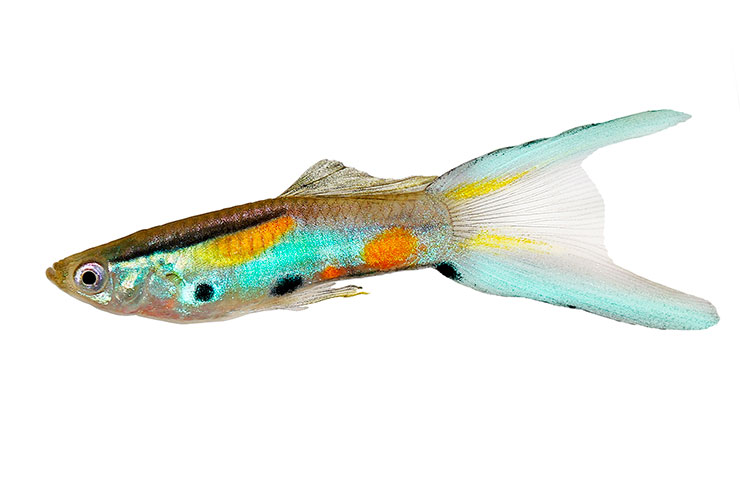
It is better to keep in small groups with a predominance of females. It is advisable for the aquarium to be densely planted with plants. Fish are very mobile, males constantly look after females. They can jump out of open aquariums. As neighbors, you can use small characin, zebrafish, rasbora, corridors. They usually live in an aquarium for several years. At elevated temperatures (about 30 ° C), they actively grow, but at the same time, the life span is reduced. Flakes or small granules are great for feeding. Reproduction is very simple. On average, a female spawns 5 to 25 fry every month. The fry is large and can immediately eat dry food for fry and brine shrimp nauplii.
Guppy breeds
Guppy fish have a great many variations in shapes and colors. Guppy breeds are distinguished by a set of features, the main of which are body-color, color, and shape of fins, presence of pearlescent sheen, and pattern. In some cases, there are “commercial”, historically established names (for example, “Berlin” – half-black red, “black prince” – half-black, “carnation” – dark-body carpet red, “cobra” – the correct name is “filigree”, etc. .).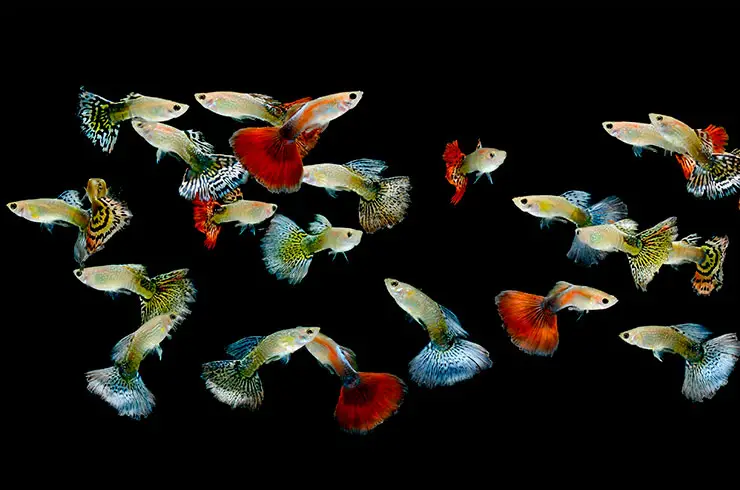
The mechanisms of the formation of the color that we observe are genetically quite complex and are due to a number of pigments, a different combination of which creates a unique variety of colors of existing breeds. Until now, a unified nomenclature for the names of breeding breeds of these fish has not been adopted. In addition, the offspring of guppies of a certain color will always split and new colors will appear, which leads to confusion and makes it difficult to maintain a clean line.
When maintaining a line in the aquarium, after several generations, “degeneration” usually occurs, that is, the signs of the breed can disappear or undergo significant changes, in addition, the viability of the fish significantly deteriorates. This occurs as a result of inbreeding, or closely related crossbreeding. To prevent this from happening, when breeding guppies, it is necessary to periodically add new “blood”, that is, to cross with representatives of the same breed, but taken from another breeder.
It should be noted that pure lines of guppy breeds can only be found in breeders’ aquariums, as maintaining the breed requires considerable effort, long time, and adherence to strict growing and selection conditions. Hybrids of different breeds are usually commercially available, exhibiting a wide variety of traits.
Consider the most popular guppy breeds among aquarists.
- Guppy Cobra (SnakeSkin)
The more correct name for this breed is filigree guppy. The main distinguishing feature is randomly distributed spots with a metallic sheen all over the body. Such a pattern is very reminiscent of a snakeskin pattern, for which the breed got its name. There are several color varieties within the breed: Red Cobra, Yellow (Gold) Cobra, Blue Cobra, and the most common Green Cobra.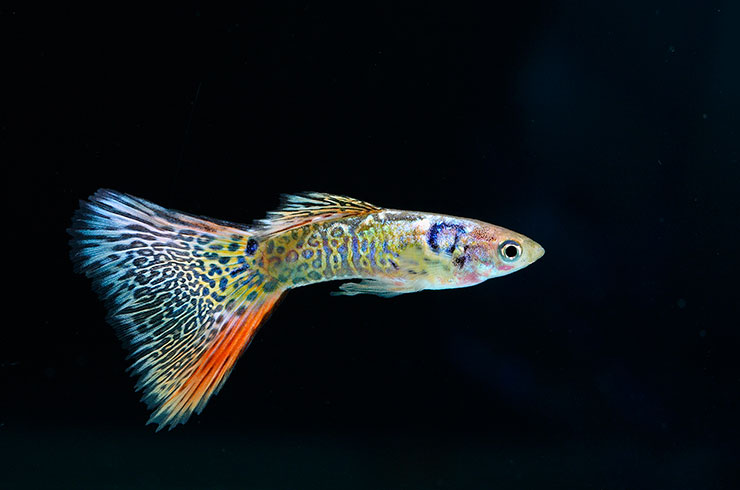
- Guppy rugs
They are characterized by a red-brown tail, sometimes with sparkles. The body is brown or orange-yellow in color. The breed also has a “carnation” shape – there is a red-silver or pink-silver ornament on the caudal fin. Veil emerald – the tail and body with an emerald hue, which is clearly visible in reflected light.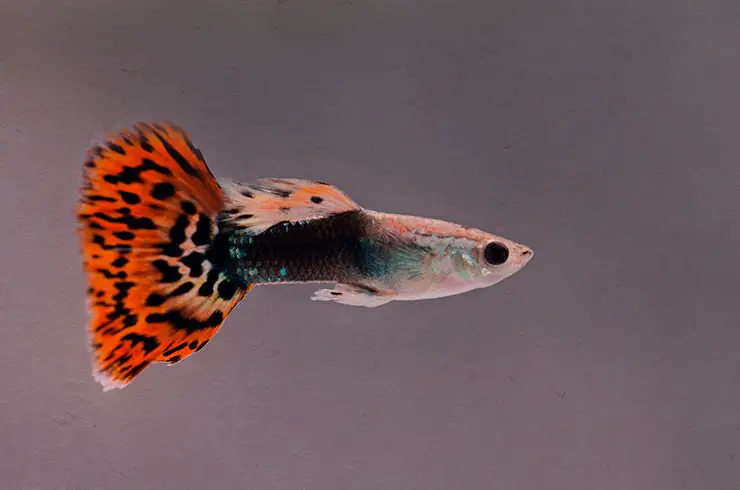
- Half-length
The front third of the body is silvery, the rest, including the caudal fin, is velvety black. A silvery ornament is observed on the tail and dorsal fin. An example would be half blue, half white (Canadian), half black (black prince).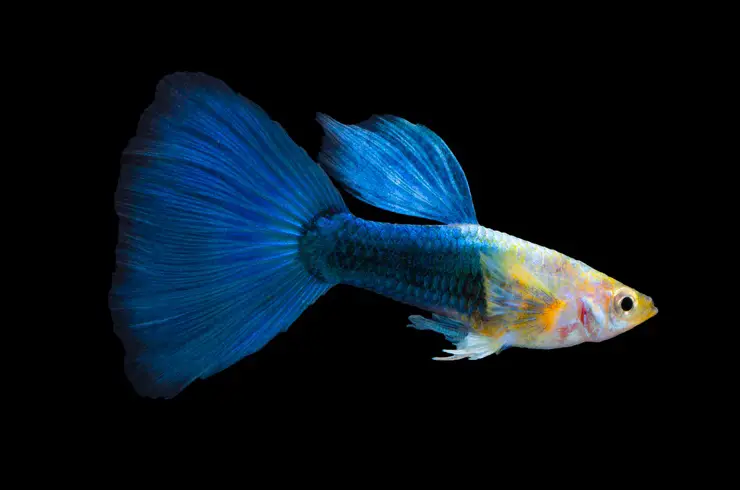
- Monochromatic
The body is uniformly colored in one color, sometimes with a metallic sheen. An example is Moscow Green, Moscow Black, etc.
- Reticulated guppies
The body of the fish is gray, all over the body, there is a small silvery ornament in the form of a grid.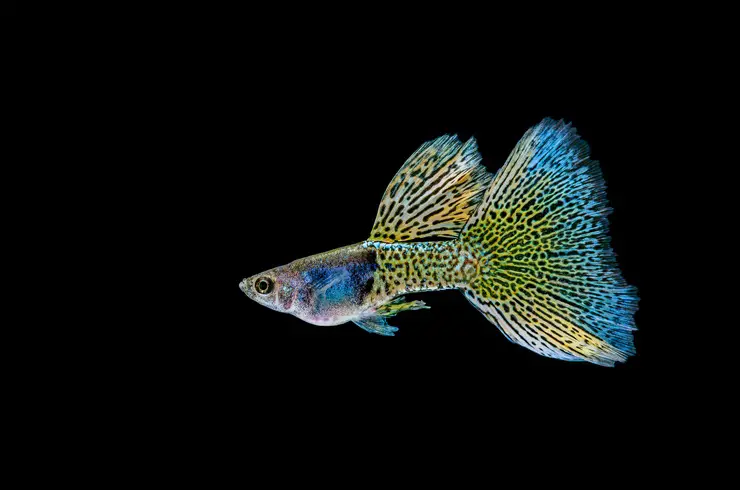
Care and maintenance of Guppy
Due to the high endurance of the guppy, there is an opinion that creating good conditions for the fish does not really matter. But this approach is fundamentally wrong. Guppies, like any other fish, require compliance with certain rules for keeping. Only in this case the pet will live a long life, will not be susceptible to diseases, will remain active, and will not lose its excellent shape.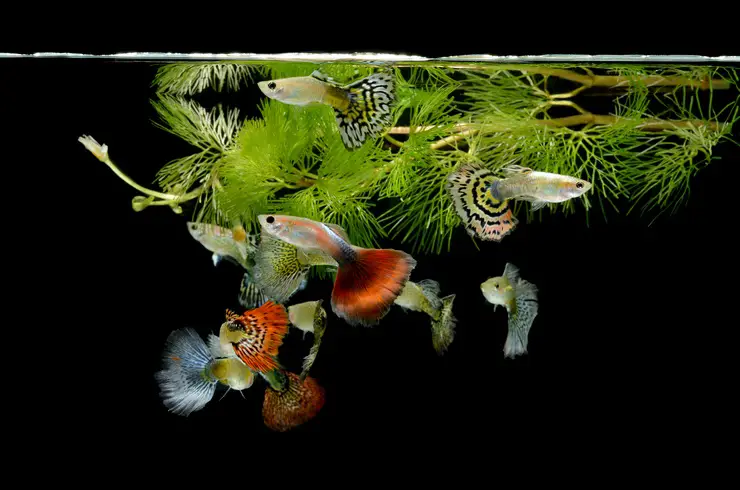
Guppies are best kept in small groups of 6 or more. In an aquarium, they swim in all layers of water. Fish must be selected so that there are 2-3 females per male – in this case, females will be less attacked by males ready for spawning. For a flock of 6-10 pieces, you need an aquarium from 50 liters. Any soil is suitable, the main thing is that it should be without sharp edges and preferably a dark shade, with it the fish look more spectacular. The same requirement applies to decorations. This is to prevent males from damaging their plush tails. It is advisable to set the lighting bright: with it, the guppies look better and acquire a more saturated color. It is best to cover the aquarium with a lid because the fish can quite easily jump out of the water and land on the floor.
Guppies feel good in clean, oxygenated water, the main thing is that the filter flow is not very strong: it is difficult for small fish to resist a strong flow of water. The optimum temperature for keeping this tropical fish is 24-26 ° C, although guppies can exist in the range from 18 to 30 ° C. The lifetime strongly depends on the temperature. The higher the indicator, the faster the metabolism goes, the reproduction process becomes more frequent, but the life span is reduced. If the fish is in the lower limit of temperature, then its metabolism slows down, the reproductive function is suspended.
Water with a hardness of 10-25 ° dGH and an acidity of 7-8.5 is suitable for keeping guppies. However, water parameters are not an axiom. If the changes were not too drastic, then the guppies adapt without problems to almost any conditions in a short time. To maintain well-being, weekly aquarium water changes (25-30%) are required.
Guppies love dense thickets of plants. It is best to give preference to small-leaved plants with delicate leaves (hornwort, Cabomba, ludwigia, etc.). It is very useful to keep an Indian fern (Ceratopteris tralictroides) in an aquarium with a guppy – it serves as a good biofilter, an indicator of water condition, and a place where fry can also hide. It is imperative to leave free swimming space in the aquarium.

